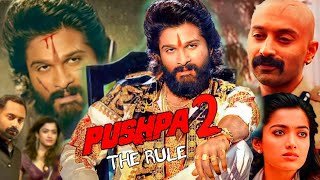Introduction: A New Breed of Mass Hero Emerges
In a cinematic landscape dominated by conventional heroes, Pushpa: The Rise storms in like a feral force of nature. Directed by Sukumar and headlined by Allu Arjun in a career-defining role, this Telugu-language action-drama transcends formulaic action to become a visceral exploration of survival, defiance, and the raw human need for self-worth.
What begins as the story of a red sandalwood smuggler evolves into something more profound—a tale of resistance against social hierarchies, systemic humiliation, and identity erasure. Pushpa isn’t just a gangster story; it’s a layered, psychological odyssey told through blood, bark, and blistering ambition.
Narrative Arc: From Dust to Power
The film charts the meteoric rise of Pushpa Raj, a daily wage laborer in the illegal red sandalwood trade, who transforms from a low-level worker into the most feared name in the forest. The backdrop is Seshachalam—a forest rich with red sandalwood, equally rich in metaphor. The story is as much about territorial dominance as it is about internal assertion.
Pushpa is illegitimate by birth. Born out of wedlock, he carries a surname that society refuses to grant him. This rejection is not just social but psychological. Every step he takes into the world of smuggling is not merely an act of ambition—it is a rebellion against his namelessness.
He doesn’t just want money or power—he wants to be seen, respected, named.
The Forest as Symbol: Raw Nature, Raw Man
The forest isn’t just a setting—it is a character. A pulsating, living organism that mirrors Pushpa’s primal instincts. Every tree cut, every sandalwood log smuggled, is part of a larger, symbolic war: man versus the system; roots versus rejection.
Sukumar paints the forest with a dusty, golden palette—sunlight filters through trees like divine illumination upon the damned. In these woods, laws do not apply. Hierarchies are built not on class, but on cunning. And Pushpa thrives because he understands its language. He bends rules, breaks them when needed, but never lets go of his code—his personal dharma.
Pushpa Raj: The Antihero Redefined
1. The Core of Defiance
Pushpa is born with two strikes against him: poverty and illegitimacy. But what sets him apart is his refusal to bow. He walks with his shoulders raised, his chin up, his body language spelling out “I will not kneel.” His swagger is not borrowed—it’s earned through scars.
He never chases sympathy. He demands respect. And when it isn’t given, he takes it by force.
2. The Use of Physicality and Silence
Allu Arjun delivers a performance that’s both flamboyant and internalized. His shoulders slant like a man ready to fight. His gait is unique—half-limp, half-challenge. He doesn’t say much early on, but his silence is volcanic. He measures his words, conserving energy like a predator waiting to strike.
Even when he smiles, it’s crooked—like he’s mocking the world’s audacity to underestimate him.
3. Masculinity and Vulnerability
Unlike typical alpha heroes, Pushpa bleeds. He breaks down. He suffers humiliations and betrayals. But he feels every loss and responds not with tears, but with revenge or reinvention. His masculinity is not stoic—it’s kinetic.
When love eludes him or power slips from his fingers, he doesn’t philosophize—he adapts. That adaptability is his weapon.
Thematic Core: Class, Identity, and Power
1. Legitimacy and the Hunger for Identity
Pushpa’s journey is not about becoming a don—it’s about becoming somebody. A man born without a name fights to carve his own. The denial of a surname haunts him like a ghost. Every slap he receives from society is laced with the venom of “you don’t belong.”
That hunger for legitimacy becomes the engine of his fury. When others chase wealth, he chases acknowledgment. His need is spiritual, not material. And that’s what makes him dangerous—because he is not driven by greed, but by void.
2. The Politics of Respect
Pushpa doesn’t kill for fun. He doesn’t harm without reason. But he demands izzat—respect. In one of the film’s most defining scenes, he proclaims, “Pushpa naam sunkar flower samjhe kya? Fire hai main.” This isn’t a line—it’s a declaration of war against every institution that’s ever made him feel small.
He doesn’t want to sit at the table of the elite. He wants to flip it.
3. Power and Its Cost
As Pushpa ascends the smuggling hierarchy, the cost becomes visible. Trust erodes. Allies turn rivals. Love grows distant. The higher he climbs, the more isolated he becomes.
His body is bruised, but so is his soul. What he gains in dominance, he loses in intimacy. He becomes a myth—but myths, by nature, are lonely.
Rashmika Mandanna as Srivalli: Love Amidst Chaos
Srivalli is more than a love interest. She represents the “normal life” Pushpa yearns for but can never truly have. Their romance isn’t idealized—it’s rooted in class, misunderstanding, and eventual respect.
Srivalli sees Pushpa’s rage, but also his ache. Their relationship becomes a small, tender rebellion against a world soaked in blood. In a film of gang wars and betrayals, their scenes breathe softness—even as they underscore the impossibility of happiness for men like Pushpa.
Fahadh Faasil as SP Bhanwar Singh Shekhawat: Collision Course
The introduction of Bhanwar Singh in the latter half reshapes the narrative. Here comes a man of the system—calculating, corrupt, sadistic. In him, Pushpa finds a new kind of enemy—not a rival smuggler, but someone who wields institutional power with surgical cruelty.
Their clash is philosophical. Pushpa is jungle law—feral, chaotic, driven by instinct. Bhanwar is the polished fist of the state—disciplined, but just as ruthless.
Their encounter is not just about dominance—it’s about narrative control. Who gets to write the ending?
Cinematic Techniques: Mythic Realism and Mass Style
Sukumar blends gritty realism with mythic elevation. Every fight scene, every standoff, is choreographed not just for impact, but for symbolism. Pushpa doesn’t fight; he announces himself through violence. The action is balletic, but brutal.
The use of slow motion is deliberate—not indulgent. It forces the viewer to soak in Pushpa’s power. Every punch, every glare, is elongated because in Pushpa’s world, time bends for the powerful.
The background score by Devi Sri Prasad functions like an echo of Pushpa’s inner voice—wild, tribal, untamed.
The Climax: A Crown Without a Kingdom
The film ends not with resolution, but with elevation. Pushpa rises—but what he inherits is not peace, but war. He earns the right to be feared, but not the right to rest.
The final confrontation between Pushpa and Bhanwar sets the stage for something greater. The fire that Pushpa speaks of is not extinguished—it’s just begun to spread.
We are left not with closure, but with promise. The promise that this man, born nameless, will rewrite the rules not just of the forest—but of fate itself.
Conclusion: Pushpa as Archetype of the Modern Mass Hero
Pushpa: The Rise is more than a film—it is a cultural pulse. It doesn’t just entertain—it claims space. It proves that the mass hero in Indian cinema is evolving. No longer clean-cut, moralistic, or gentle, he is now scarred, raw, and shaped by rejection. He speaks in dialect, walks with a limp, and screams for justice through acts of defiance.
Pushpa is not a man of the law. He is a man of lore. A symbol of what happens when the invisible decide to become unforgettable.
He is fire. Not in the sense of rage alone—but of transformation.

